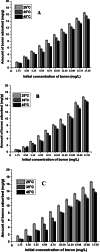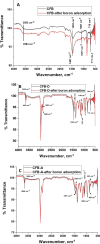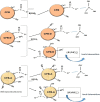Modified os sepiae of Sepiella inermis as a low cost, sustainable, bio-based adsorbent for the effective remediation of boron from aqueous solution
- PMID: 35589901
- PMCID: PMC9515050
- DOI: 10.1007/s11356-022-20578-3
Modified os sepiae of Sepiella inermis as a low cost, sustainable, bio-based adsorbent for the effective remediation of boron from aqueous solution
Abstract
The occurrence of boron in low concentration is essential; however, a higher concentration of boron source in water has a toxic effect on humans as well as have retard effect on agricultural plant growth. Thus, the affordable and facile method to remediate water from higher boron concentrations is highly demanded. This report explores the ability of naturally occurring sustainable bio-waste os sepiae (cuttlefish bone, CFB) as an effective adsorbent for the removal of boron from water. Chemical activation of the os sepiae powder was examined to improve the efficiency of boron adsorption. A batch adsorption study for boron considering various parameters such as chemical modification of os sepiae, pH, initial boron concentration, and the temperature was scrutinized. Untreated (CFB), alkali-treated (CFB-D) and acid-treated (CFB-A) os sepiae powders were investigated and the adsorption capacities reached up to 53.8 ± 0.04 mg/g, 66.4 ± 0.02 mg/g and 69.8 ± 0.02 mg/g, respectively, at optimal pH 8 and 25 °C. Boron adsorption by CFB, CFB-D, and CFB-A were well fitted with the linear Freundlich adsorption isotherm model with a correlation coefficient of 99.4%, 99.8%, and 99.7% respectively. Thermodynamic parameters indicated that the adsorption of boron by CFB is an exothermic process and more feasible at a lower temperature around 25 °C. Moreover, detailed morphological and chemical characterization of the influence of adsorbed boron on adsorbents was conducted and discussed. The Fourier transform infrared spectroscopy (FTIR) and X-ray photoelectron spectroscopy (XPS) analysis spectra confirms the involvement of various functional groups including amino, carbonate (CO3)2-, and hydroxyl groups on the adsorbent in the adsorption mechanisms for boron removal. The results indicate that CFB can be an excellent example for the recycling and reuse of biowaste for water remediation.
Keywords: Adsorption; Boron; Os sepiae; Upcycling; Water treatment.
© 2022. The Author(s).
Conflict of interest statement
The authors declare no competing interests.
Figures












Similar articles
-
Characterization of metal removal by os sepiae of Sepiella maindroni Rochebrune from aqueous solutions.J Hazard Mater. 2010 Jul 15;179(1-3):266-75. doi: 10.1016/j.jhazmat.2010.03.001. Epub 2010 Mar 4. J Hazard Mater. 2010. PMID: 20347221
-
A new adsorbent for boron removal from aqueous solutions.Environ Technol. 2013 May-Jun;34(9-12):1369-76. doi: 10.1080/09593330.2012.750380. Environ Technol. 2013. PMID: 24191469
-
Co-modified MCM-41 as an effective adsorbent for levofloxacin removal from aqueous solution: optimization of process parameters, isotherm, and thermodynamic studies.Environ Sci Pollut Res Int. 2017 Feb;24(6):5238-5248. doi: 10.1007/s11356-016-8262-0. Epub 2016 Dec 21. Environ Sci Pollut Res Int. 2017. PMID: 28004365
-
Eggshell membrane as a novel bio sorbent for remediation of boron from desalinated water.J Environ Manage. 2018 Feb 1;207:405-416. doi: 10.1016/j.jenvman.2017.11.062. Epub 2017 Nov 28. J Environ Manage. 2018. PMID: 29190483
-
Recent advances in boron removal in aqueous media. An approach to the adsorption process and process optimization.Environ Sci Pollut Res Int. 2024 Feb;31(8):12207-12228. doi: 10.1007/s11356-024-31882-5. Epub 2024 Jan 16. Environ Sci Pollut Res Int. 2024. PMID: 38225497 Review.
Cited by
-
Characterization of Heavy Metal Ions Removal from Water by Improved Cuttlebone Powder with Magnetic Fe3O4 Nanoparticle as a Bioadsorbent.Glob Chall. 2025 Jan 7;9(2):2400107. doi: 10.1002/gch2.202400107. eCollection 2025 Feb. Glob Chall. 2025. PMID: 39925672 Free PMC article.
-
Magnetic Separation of Oxoacid of Boron from Salt-Lake Brine by Synergistically Enhanced Boron Adsorbents of Glucose-Functionalized SiO2 and Graphene.Int J Mol Sci. 2022 Sep 26;23(19):11356. doi: 10.3390/ijms231911356. Int J Mol Sci. 2022. PMID: 36232661 Free PMC article.
References
-
- Abdel-Khalek MA, Rahman MA, Francis AA. Exploring the adsorption behavior of cationic and anionic dyes on industrial waste shells of egg. J Environ Chem Eng. 2017;5(1):319–327. doi: 10.1016/j.jece.2016.11.043. - DOI
-
- Abdul Rahman A (2014) KAHRAMAA Drinking Water Quality Requirements. https://www.km.com.qa/MediaCenter/Publications/KAHRAMAA/20Drinking/20Wat.... Accessed 22 Oct 2021
-
- Ahmad R, Kumar R, Haseeb S. Adsorption of Cu2+ from aqueous solution onto iron oxide coated eggshell powder: Evaluation of equilibrium, isotherms, kinetics, and regeneration capacity. Arab J Chem. 2012;5(3):353–359. doi: 10.1016/j.arabjc.2010.09.003. - DOI
-
- Ahmed FE, Khalil A, Hilal N. Emerging desalination technologies: Current status, challenges and future trends. Desalination. 2021;517:115183. doi: 10.1016/j.desal.2021.115183. - DOI
MeSH terms
Substances
Grants and funding
LinkOut - more resources
Full Text Sources
Miscellaneous

